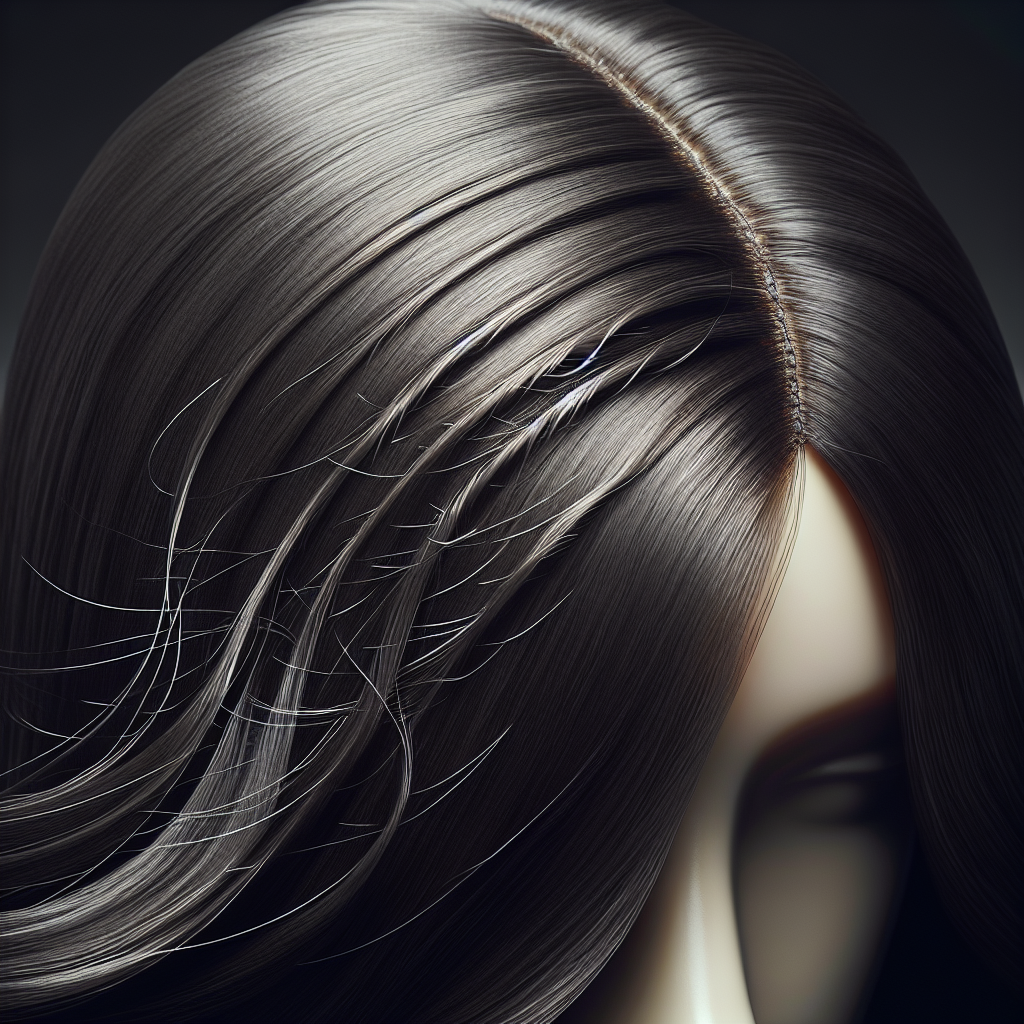Imagine this scenario: you’ve recently invested in a gorgeous human hair wig that beautifully mimics your own luscious locks. As you admire it, a nagging thought crosses your mind – could this wig develop split ends, just like your natural hair? It’s a valid concern, and in this article, we will explore whether a human hair wig is susceptible to split ends. We will delve into the factors that contribute to split ends, how to prevent them, and provide tips on maintaining the longevity of your wig. So, let’s put those worries to rest and get ready to learn everything there is to know about split ends and human hair wigs!

Hair Structure
Hair Shaft
The hair shaft refers to the visible part of the hair that extends beyond the scalp. It is composed of three layers: the cuticle, cortex, and medulla.
Hair Cuticle
The hair cuticle is the outermost layer of the hair shaft and serves as a protective barrier. It consists of overlapping scales that lay flat when the hair is healthy, resulting in a smooth and shiny appearance.
Hair Cortex
The hair cortex is the middle layer of the hair shaft and contains the protein-rich cells that provide the hair with strength and elasticity. It determines the hair’s texture, thickness, and color.
Hair Medulla
The hair medulla is the innermost layer of the hair shaft and consists of cells that contain air spaces. This layer is not always present in all hair types.
What are Split Ends?
Definition
Split ends, also known as trichoptilosis, occur when the hair shaft becomes damaged and splits apart. They typically appear as small, frayed strands at the end of the hair shaft.
Causes of Split Ends
There are several factors that can contribute to the development of split ends. Excessive heat styling, such as using hair straighteners or curling irons, can strip the hair of its natural moisture and make it more prone to splitting. Chemical treatments, like coloring or perming, can also weaken the hair structure and lead to split ends. Additionally, harsh brushing or combing, exposure to environmental factors like sun and wind, and using low-quality hair products can further contribute to the problem.
Can Human Hair Wigs Get Split Ends?
Human Hair Wigs vs. Natural Hair
While human hair wigs are made from real hair, they can still be susceptible to split ends due to the lack of natural oils and protective nutrients that are present in the scalp. However, compared to natural hair, human hair wigs tend to be stronger and more resistant to damage.
Factors Affecting Split Ends in Human Hair Wigs
Several factors can affect the occurrence of split ends in human hair wigs. The quality of the hair used, the manufacturing process, and the care and maintenance routine all play a crucial role. If the hair used for the wig is of low quality or has undergone extensive chemical processing, it may be more prone to developing split ends. Similarly, improper care and over-styling can contribute to the problem.
Maintenance and Prevention
Regular Trimming
Just like with natural hair, regular trimming is essential to prevent and manage split ends in human hair wigs. Trimming the ends every 6-8 weeks helps to remove the damaged sections and maintain the overall health of the wig.
Avoiding Excessive Heat
High heat can damage the hair shaft, leading to split ends. Therefore, it is important to avoid excessive heat when styling human hair wigs. Opt for lower heat settings on styling tools and make use of heat protectant products to minimize damage.
Gentle Brushing
Using a wide-toothed comb or a brush specifically designed for wigs can help reduce breakage and minimize the risk of split ends. Start by brushing the ends first and gradually move upwards, holding the hair gently to avoid tugging or pulling.
Moisturizing
Since human hair wigs lack the natural oils produced by the scalp, it is crucial to moisturize them regularly. Applying a leave-in conditioner or a lightweight oil to the ends of the wig can help nourish and hydrate the hair, reducing the likelihood of split ends.
Using Protective Products
Using products specifically formulated for human hair wigs, such as heat protectants and serums, can provide an extra layer of protection against split ends. These products help to shield the hair from environmental factors and minimize damage caused by styling or exposure to harsh elements.

Signs of Split Ends in Wigs
Appearance
One of the most obvious signs of split ends in human hair wigs is the appearance of frayed or uneven hair strands at the ends. These split ends may look dull, dry, and lack the natural shine associated with healthy hair.
Texture
Split ends can also affect the texture of the hair. The ends may feel rough and coarse to the touch. This change in texture is a result of the damaged cuticle layer and can make styling and managing the wig more challenging.
Tangling and Matting
Hair that is damaged and has split ends is more prone to tangling and matting. The split ends can catch onto other strands, leading to knots and tangles. If left untreated, this can cause further damage and make the wig appear unkempt.
Treatment for Split Ends in Wigs
Trimming
The most effective way to treat split ends in human hair wigs is by trimming them off. To prevent further damage, it is recommended to have the wig trimmed by a professional stylist who is familiar with working on wigs. This will ensure an even cut and minimize the risk of accidentally cutting off too much hair.
Sealing
Sealing the ends of the wig with a specialized product can temporarily minimize the appearance of split ends. These sealants work by smoothing down the cuticle layer, holding the damaged hair together, and offering a temporary fix until a trim can be done.
Hair Mask
Applying a nourishing hair mask to the ends of the wig can help restore moisture and repair the damaged cuticle layer. Look for masks that contain hydrating ingredients like shea butter, argan oil, or keratin. Leave the mask on for the recommended amount of time before rinsing it out thoroughly.
Professional Care
For more severe cases of split ends or if the wig is damaged beyond repair, seeking professional care might be necessary. Professional wig stylists can assess the condition of the wig and provide the appropriate treatment, such as deep conditioning or repair services, to revive the hair and eliminate split ends.
Tips and Tricks
Using a Wide-Toothed Comb
When detangling and styling a human hair wig, opt for a wide-toothed comb instead of a brush. Wide-toothed combs are gentler on the hair and help prevent unnecessary breakage and split ends.
Avoiding Chemical Treatments
To minimize the risk of split ends, it is best to avoid exposing the wig to harsh chemical treatments such as hair dyes, relaxers, or perms. These treatments can strip the hair of its natural moisture and weaken the overall structure.
Protective Hairstyles
To protect the ends of the wig from friction and environmental damage, opt for protective hairstyles such as braids, buns, or updos. These styles keep the ends tucked away and minimize the risk of split ends.
Avoiding Excessive Styling
Excessive heat styling and over-manipulation can cause damage and lead to split ends. Limit the use of heat styling tools and avoid constantly changing hairstyles to give the wig a break and promote healthier hair.
Watching for Environmental Factors
Environmental factors such as sun exposure, extreme temperatures, and wind can contribute to the development of split ends. Whenever possible, protect the wig from these elements by wearing a hat or using a scarf.
Quality of Human Hair Wigs
Source and Processing
The quality of the human hair used for wigs depends on its source and processing. Hair sourced from reputable suppliers and processed using gentle methods will result in higher-quality wigs that are less prone to split ends.
Remy vs. Non-Remy Hair
Remy hair refers to hair that has been carefully collected to ensure that the cuticles are aligned in the same direction. This results in a smoother and more natural-looking wig that is less likely to develop split ends. Non-Remy hair, on the other hand, has cuticles that are not aligned, making it more susceptible to damage and split ends.
Choosing a Reputable Seller
To ensure the quality of the human hair wig and minimize the risk of split ends, it is important to choose a reputable seller. Look for sellers who have positive reviews, provide detailed information about their products, and offer customer support. This will help ensure that the wig you purchase is of good quality and has been properly processed.
Longevity of Human Hair Wigs
Hair Care Routine
Establishing a proper hair care routine is crucial for maintaining the longevity of human hair wigs and preventing split ends. This routine should include regular washing, conditioning, and moisturizing, as well as protective styling and avoiding harsh treatments.
Storage and Cleaning
Proper storage and cleaning of the wig are essential to prevent damage and minimize split ends. When not in use, store the wig in a cool and dry place, preferably on a wig stand or in a protective case. Regularly clean the wig using gentle products and follow the manufacturer’s instructions for optimal care.
Regular Inspections
To catch any potential split ends or signs of damage early on, it is important to regularly inspect the wig. Check the ends for fraying or dryness and feel the texture to assess its overall condition. Taking proactive measures will help to address any issues promptly and prevent further damage.
Conclusion
While human hair wigs can develop split ends, proper care and maintenance can minimize their occurrence and keep the wig looking healthy and beautiful. Regular trimming, avoiding excessive heat, using gentle brushing techniques, and moisturizing the hair are all vital in preventing split ends. By adopting a diligent hair care routine and making use of quality products, you can ensure the longevity and quality of your human hair wig, allowing you to enjoy its beauty for a longer time.
